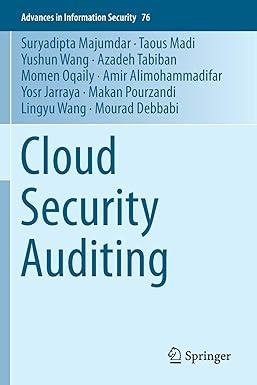Question
Interpreting and Applying Disclosures on Property and Equipment Following are selected disclosures from the Rohm and Haas Company (a specialty chemical company) 2005 10-K. Land,
Interpreting and Applying Disclosures on Property and Equipment Following are selected disclosures from the Rohm and Haas Company (a specialty chemical company) 2005 10-K.
| Land, Building and Equipment, Net | ||
|---|---|---|
| (in millions) | 2005 | 2004 |
| Land | $ 139 | $ 141 |
| Buildings and improvements | 1,683 | 1,744 |
| Machinery and equipment | 5,570 | 5,656 |
| Capitalized interest | 329 | 320 |
| Construction in progress | 168 | 166 |
| Land, Building and Equipment, Gross | 7,889 | 8,027 |
| Less: Accumulated depreciation | 5,208 | 5,098 |
| Total | $ 2,681 | $ 2,929 |
The principal lives (in years) used in determining depreciation rates of various assets are: buildings and improvement (10-50); machinery and equipment (5-20); automobiles, trucks and tank cars (3-10); furniture and fixtures, laboratory equipment and other assets (5-10); capitalized software (5-7). The principal life used in determining the depreciation rate for leasehold improvements is the years remaining in the lease term or the useful life (in years) of the asset, whichever is shorter. IMPAIRMENT OF LONG-LIVED ASSETS Long-lived assets, other than investments, goodwill and indefinite-lived intangible assets, are depreciated over their estimated useful lives, and are reviewed for impairment whenever changes in circumstances indicate the carrying value of the asset may not be recoverable. Such circumstances would include items such as a significant decrease in the market price of a long-lived asset, a significant adverse change in the manner the asset is being used or planned to be used or in its physical condition or a history of operating or cash flow losses associated with the use of the asset ... When such events or changes occur, we assess the recoverability of the asset by comparing the carrying value of the asset to the expected future cash flows associated with the asset's planned future use and eventual disposition of the asset, if applicable...We utilize marketplace assumptions to calculate the discounted cash flows used in determining the asset's fair value. In 2005, $81 million of asset impairments were recognized for the impairment of certain finite-lived intangible assets and fixed assets across several of our chemical businesses and our Electronic Materials segment.
(a) Compute the PPE (land, buildings and equipment) turnover for 2005 (Sales in 2005 are $7,994 million). (Round your answer to two decimal places.) Answer If the median PPE turnover rate for all publicly traded companies is approximately 5.03 in 2005, what does Rohm and Haas's turnover rate tell us about the company?
Rohm and Haas is more capital intensive than the median publicly traded company.
Rohm and Haas is less capital intensive than the median publicly traded company.
Rohm and Haas is the same capital intensive as the median publicly traded company.
The PPE turnover rate does not tell us anything about how capital intensive Rohm and Haas is.
(b) Rohm and Haas reported depreciation expense of $422 million in 2005. Estimate the useful life, on average, for its depreciable PPE assets. (Round your answer to two decimal places.) Answeryears (c) By what percentage are Rohm and Haas' assets "used up" at year-end 2005? (Round your answer to two decimal places.) Answer% Which of the following statements best captures the implication that the assets "used up" computation has for forecasting cash flows?
Rohm and Haas's assets are not particularly "used up" according to this computation. We, therefore, do not expect adverse implication for future cash flow.
A percentage "used up" substantially above 50% indicates that the assets are closer to the end of their useful lives. This means that the depreciation expense will decrease and this in turn will have a positive impact on future cash flows.
A percentage "used up" substantially above 50% indicates that the assets are closer to the end of their useful lives and will require replacement. Such a situation would negatively impact future cash flows.
The assets "used up" computation can not tell us anything about future cash flows.
(d) Rohm and Haas reports an asset impairment charge in 2005. Which of the following statements best captures the implications of asset impairment charges (write-offs)?
Plant assets are deemed to be impaired if their market value is less than their book value, even if temporary. We should treat these write-downs as recurring (operating) items because future write-downs are inevitable.
Plant assets are deemed to be impaired if the undiscounted expected future cash flows from those assets are not sufficient to recover their net book value. Because assets impairment charges are arguably nonrecurring, one might use this to justify treating them as transitory items for analysis purposes.
Plant assets are deemed to be impaired if the undiscounted expected future cash flows from those assets are not sufficient to recover their net book value. We should treat these write-downs as recurring (operating) items because future write-downs are inevitable.
Plant assets are deemed to be impaired if their market value is less than their book value, even if temporary. We should treat these write-downs as transitory.
Step by Step Solution
There are 3 Steps involved in it
Step: 1

Get Instant Access to Expert-Tailored Solutions
See step-by-step solutions with expert insights and AI powered tools for academic success
Step: 2

Step: 3

Ace Your Homework with AI
Get the answers you need in no time with our AI-driven, step-by-step assistance
Get Started


